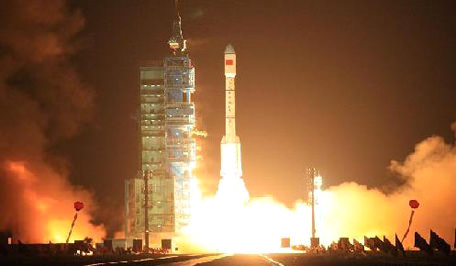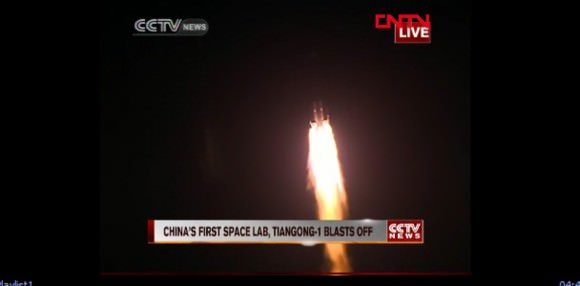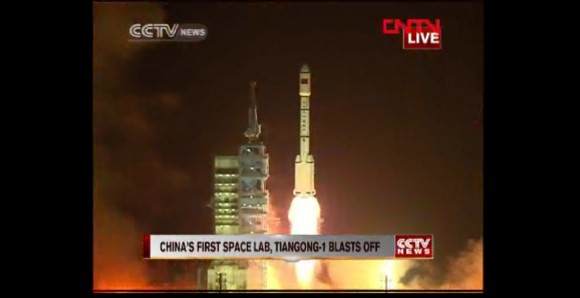[/caption]
China launched their first space station module into orbit today (Sept. 29), marking a major milestone in the rapidly expanding Chinese space program. The historic liftoff of the man rated Tiangong 1 (Heavenly Palace 1) space lab on a Long March 2F rocket took place at 9:16 p.m. local time (9:16 a.m. EDT) from the Jiuquan Satellite Launch Center located in Gansu province in northwest China and is an impressive advance for China.
The beautiful nighttime liftoff occurred exactly on time and was carried live on China’s state run television – CCTV – and on the internet for all to see. Chinese President Hu Jintao and many of China’s other top government leaders witnessed the launch from the Beijing Aerospace Control Center as a gesture of confidence and support. Their presence was a clear sign of just how important China’s top leadership considers investments in research as a major driver of technological innovation that is bolstering China’s vigorously growing economy and employing tens of thousands of people.
The US – in sharp contrast – is cutting space spending and handing out pink slips to many thousands of shuttle workers, CCTV noted.
As a CCTV commentator said after the successful Tiangong 1 launch, “30 Years ago it was ‘science fiction’ to imagine a Chinese astronaut in space. Today it’s a reality!”
Long range cameras tracked rocket for several minutes and clearly showed the jettisoning of the first stage boosters and the payload fairing.
“The launch of Tiangong 1 has been successfully completed,” announced Gen. Chang Wanquan, chief commander of China’s manned space engineering project on CCTV

Tiangiong 1 will serve a crucial role as a docking target to carry out China’s first rendezvous and docking in space- initially with an unmanned vehicle and thereafter with astronauts crews. The US and the Soviet Union mastered these technologies back in the 1960’s, and China is rapidly catching up now.
Rendezvous and docking are key accomplishments that China must achieve in order to move forward and accomplish even more ambitious space goals – construction of a 60 ton space station by the year 2020.
The two stage Long March 2F rocket was upgraded with more than 170 improvements including a larger payload fairing to house bigger Tiangong 1 module, four longer liquid fueled strap on boosters with more powerful thrust capability and more precise guidance systems.
The 8.5 ton Tiangong 1 was designed to stay in space for at least 2 years and support crews of up to three astronauts for short duration stays. It will be the target of at least three upcoming space missions – Shenzhou 8, 9 and 10.

Shenzhou is China’s human spaceflight capsule, derived from the Russian Soyuz and also significantly upgraded with China’s own nationally developed technology.
The unmanned Shenzhou 8 will launch in about 1 month according to officials from the China Manned Space Engineering Office and reach the vicinity of Tiangong 1 after 2 days. Shenzhou 8 will conduct at least two practice test dockings to extensively check out all systems and experience.
Shenzhou 9 and 10 will dock during 2012 and are likely to include the first female Chinese astronaut.
Tiangong 1 is a prototype miniture space station module, not fully outfitted for long duration stays of astronauts. The space lab consists of two segments – a forward habitable, pressurized section for the astronauts (measuring some 530 cubic feet in volume) and an unpressurized resource compartment in the rear with two solar arrays consisting of four segments to provide ample power.

Read Ken’s related feature about Tiangong 1
China set to ‘Leap Forward in Space’ as Tiangong 1 Rolls to Launch Pad


Long as they keep it clean,
HOORAH
i remember, as a kid, that i bought a toy shuttle made in china….
aahhh..the irony
I am kinda fuzzy as to the long term goals of the Chinese space program. Are try planning on doing any actual science on this space station? It seems to me that most nations bumble about in LEO simply for ‘prestige’ without any clear objectives. They want to test their orbital rendezvous capabilities, this much is evident. Then what?
For historical reasons, space stations were envisaged as stepping stones out into interplanetary space. Even today you can calculate home fuel stations as cheaper for mid-size early missions, as NASA does.
And they have their uses.
– There is a lot of space research done on them. (And I think the discovery and use of how space conditions lower the immune system eventually will recapture a lot of ISS cost alone.)
– It provides experience on how humans cope with long time space visits (not good), how to make closed enough biospheres (not developed enough) and how to protect against common space hazards (meteorites: radar combined with duck and cover seems to work; radiation: not developed enough).
– It is the best ROI option for tourism.
Obviously, to get to the Moon they are not needed. So then what, indeed? Mars should be in the chinese long range sights.*
Or perhaps they want to parallel other’s space tourism, and provide interesting travel for their upper echelons. =D
————
* Strictly speaking, you probably don’t need space stations for planetary missions either. But it should keep long term cost down, see above.
Congratulations to all of the Chinese scientists and engineers who undoubtedly worked long and hard to make this a reality!
As was noted during the live broadcast, they are essentially reproducing the feats accomplished by the Gemini program. To me, it seems as if the Chinese are shooting for the moon.
Great, and good luck!
On a side note, the ambitious space station reflects on what a great accomplishment Mir was at twice the mass. Too bad Russia couldn’t afford to keep and develop it further. On the other hand, that got us ISS.
Para 2 – ‘jesture’ ‘vigourously’ ? You’re either working too hard or too fast 🙂 Well done to the Chinese, but pity they can’t sideline political differences and pool resources with the U.S.
The Chinese patiently learned the lessons of all space-faring nations and now is using-reusing
(and wasting nothing) all materials inserted by them in earth orbit. Genius and simple!
Did the author or any readers in the US actually see this streamed live on the Internet? I tried watching it live from Los Angeles, but when I tried (via multiple links) to get to CCTV news, I got “We’re sorry, but this content cannot be streamed to your region”, and had the impression the the Internet feed was blocked here. I did not try the broadcast version, but I want to know if the claim of the article “for all to see” regarding CCTV’s coverage on the Internet, is correct. I was miffed…
go china! mankind will explore further and further into space now and faster and safer too.to think that someone in the future will ask “which space station are you going to?” and i was born when the first man went into space! what progress!! go china! go the human race into space